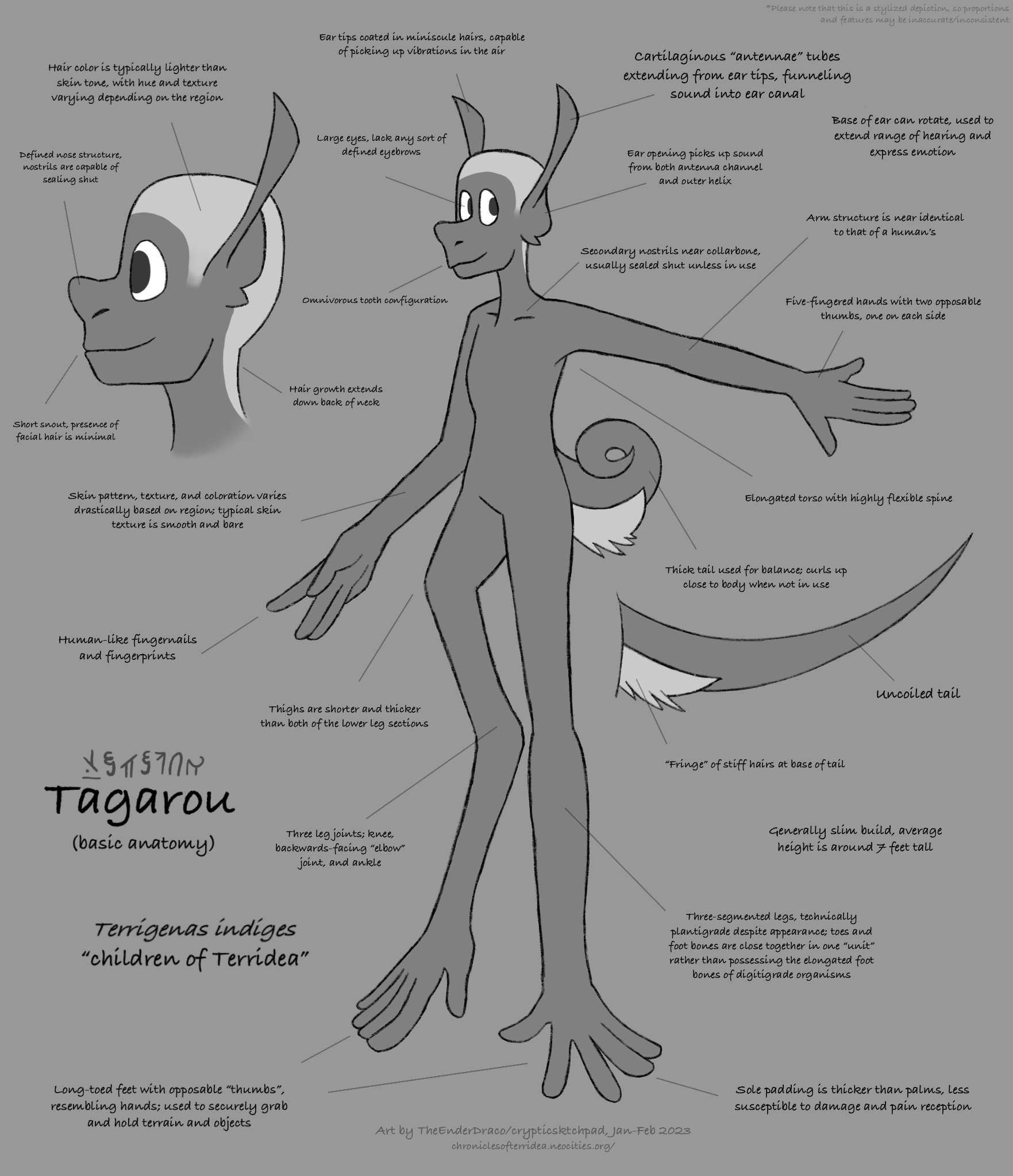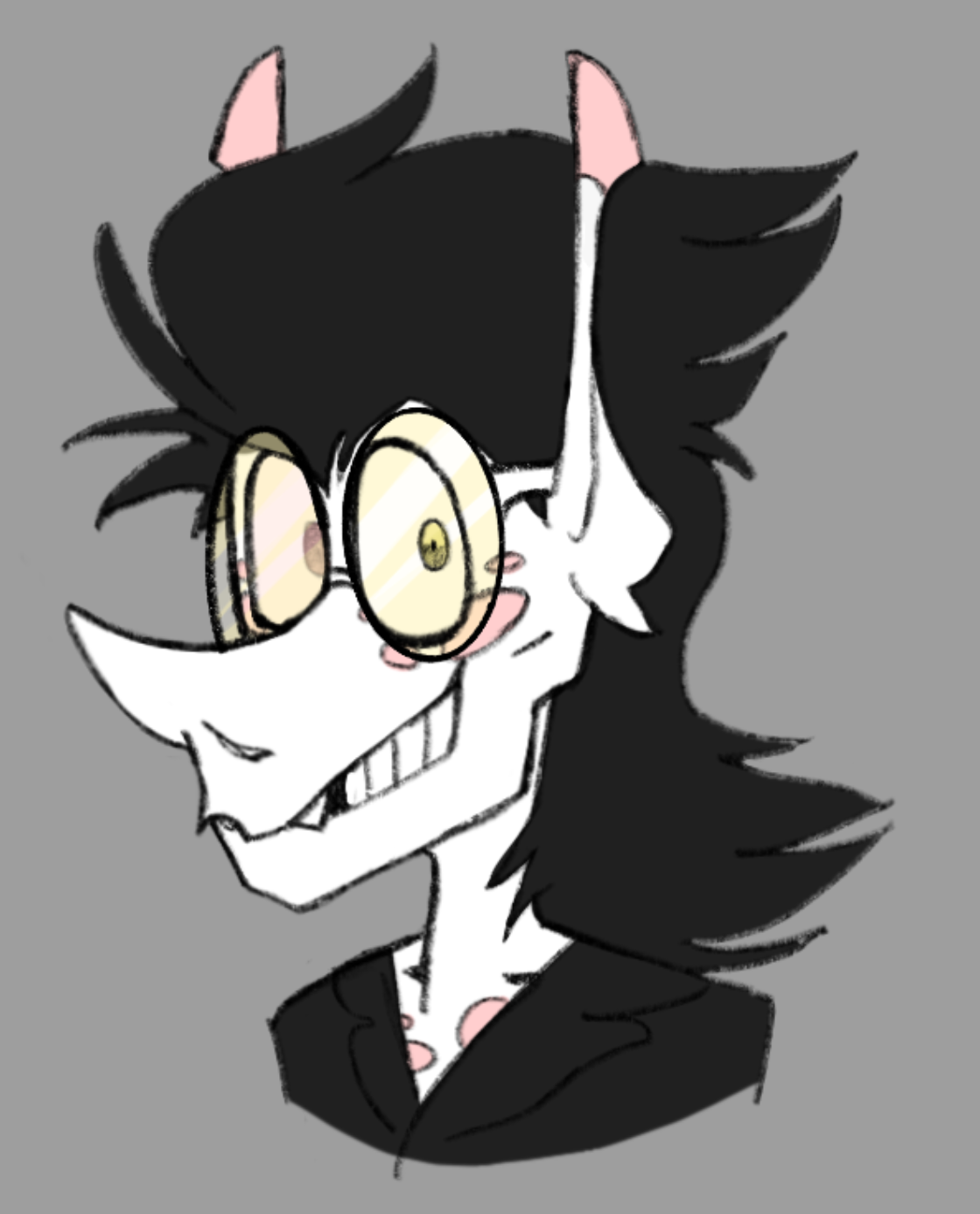Tagarou Anatomy

Basic illustration of a standard tagarou, highlighting various physical features (click to enlarge)
- Scientific Name: Terrigenas indiges
- Diet: Primarily omnivorous, varies
- Classification: Mammal (marsupial?)
- Avg. Height: 7-8 feet tall; min. 6ft, maximum 11ft
- Lifespan: 150-200 years
Tagarou are a bipedal alien species with mildly humanoid traits. They are remarkably tall, with the shortest individuals only being approximately six feet in height, and the tallest measuring at around eleven feet. One of their most prominent features are their immensely long legs, which make up just about half of their entire height. These are somewhat avian in structure, with short thighs and longer, almost arm-like lower legs. They also possess long-toed plantigrade feet with an opposable “thumb” that can be used to grab things, similar in appearance and function to a human hand. In contrast to their unusual legs, tagarou torsos are surprisingly similar in appearance to humans, albeit somewhat elongated. Their arms are near-identical to those of a human’s, with five-fingered hands sporting two opposable thumbs, one on each side.

Rough anatomical sketch of a tagarou tail, in both a coiled and uncoiled state.
Somewhat like that of a bipedal dinosaur, tagarou tails are primarily used for balance when moving, swinging from side to side in a similar function to how humans swing their arms when walking. When not in motion, their tails are kept close to their bodies, curling up into a spiral shape against their backs. Despite this curling function, their tails are not very flexible otherwise, with few exceptions depending on the region. At the base of their tails, tagarou have brush-like ridges of stiff hair that match the color of the hair on their heads. This feature originated as a decorative “train” of sorts in their pre-sapient ancestors, and remains as a purely aesthetic element. (The tail ridges of oceanic tagarou, however, have evolved into more fin-like structures, which now are used to aid in swimming.)
Body Systems & Senses

Rough anatomical sketch of the tagarou respiratory system. The respiratory system is depicted in orange, with the nostrils highlighted in blue. Also included is the cartilaginous structure that makes up their ears, depicted in pink.
A tagarou’s respiratory system is quite unusual in structure. There are three different individual passages leading to the lungs, allowing for air intake through the nose, mouth, and a secondary set of nostrils above their clavicles. Only one set of nostrils is ever active at a time, with one open to breathe and the other remaining sealed using a specific set of muscles around the openings that allows them to close completely. The larynx of a tagarou is set much lower in the body than in humans, positioned near the top of the chest directly between the lungs rather than in the throat. This also allows it to connect to both the mouth passage and lower nostrils, allowing for them to communicate in a form of less complex “chest-speech”, with the valves of the lower nostrils acting as lips.

Rough anatomical sketch of a tagarou's teeth layout, viewed from the side. The tongue is depicted in pink, and the olfactory receptors are in orange.
The olfactory receptors of tagarou are located in the roof of their mouths as well as within their sinuses, which leads to them smelling through their mouths more often than their noses. This makes the smell of food just as important to them as taste, intertwining the two senses. Tagarou tongues are rather short and less mobile than that of other species, unable to extend past their front teeth. Their tooth structure is similar to that of a bear’s, with a combination of sharp incisors and double set of fangs in front, and larger molars in the back. The exact shape of these can vary depending on the region, as some subspecies may have more herbivorous or carnivorous leaning diets than the average tagarou. Separating these two tooth groups is a notable gap in their jawbone, which is completely smooth and devoid of any sort of additional teeth or other gripping element. It is commonly theorized that this gap exists due to their formerly arboreal lifestyle, allowing them to grab branches and other objects to aid in climbing trees or to use as tools.

Very rough detail sketch of the tip of a tagarou's ear, depicting the open tip and sensitive hairs covering it.
The olfactory receptors of tagarou are located in the roof of their mouths as well as within their sinuses, which leads to them smelling through their mouths more often than their noses. This makes the smell of food just as important to them as taste, intertwining the two senses. Tagarou tongues are rather short and less mobile than that of other species, unable to extend past their front teeth. Their tooth structure is similar to that of a bear’s, with a combination of sharp incisors and double set of fangs in front, and larger molars in the back. The exact shape of these can vary depending on the region, as some subspecies may have more herbivorous or carnivorous leaning diets than the average tagarou. Separating these two tooth groups is a notable gap in their jawbone, which is completely smooth and devoid of any sort of additional teeth or other gripping element. It is commonly theorized that this gap exists due to their formerly arboreal lifestyle, allowing them to grab branches and other objects to aid in climbing trees or to use as tools.
Markings & Coloration
The skin color, hair color, and body markings of tagarou vary greatly between regions. Their markings serve as both camouflage and identification, letting them blend into their environment when needed yet be recognized by others of their own kind. Markings vary from stripes, speckles, bands, spots, and color gradations on their limbs, stomachs, and other parts. Most tagarou variants have color palettes that coordinate with their environments, for example those who live in vegetation-rich areas are primarily green in coloration, though some can have spots or markings that heavily contrast with the rest of their bodies. These contrasting bits serve as either identification between individuals (such as in Greenwilds tagarou) or ways to be seen from a distance; in larger spaces, such as the open ocean, these flashes of color allow them to be spotted by others in times of need.

Example of a tagarou with both albinism and heterochromia iridium, this one in particular of the caverns subspecies. In this case, they have chosen to dye their naturally white hair black.
In rare cases, some tagarou may be born with unusual coloration disorders such as melanism/albinism, piebaldism or heterochromia. Albino tagarou tend to have near-white skin, pale eyes, and any sort of natural markings they may have are turned completely pink.
Hair
Tagarou have hair similar to that of humans, growing primarily on the tops of their heads and further down the backs of their necks. Compared to their primary skin color, most tagarou variants have hair that is a lighter shade than the rest of their bodies, even if slightly. Having lighter skin and darker hair is uncommon, but still very much possible. The texture and growth rate of tagarou hair varies depending on climate; areas with a higher average temperature cause slower hair growth and stiffer hair texture, while colder areas cause fast growth and a softer texture.